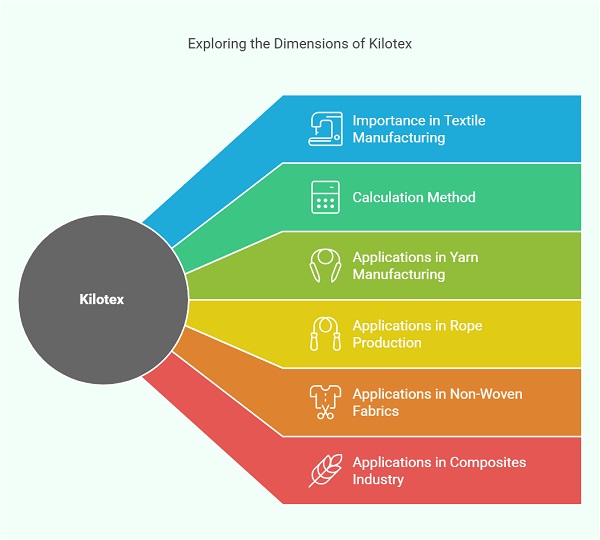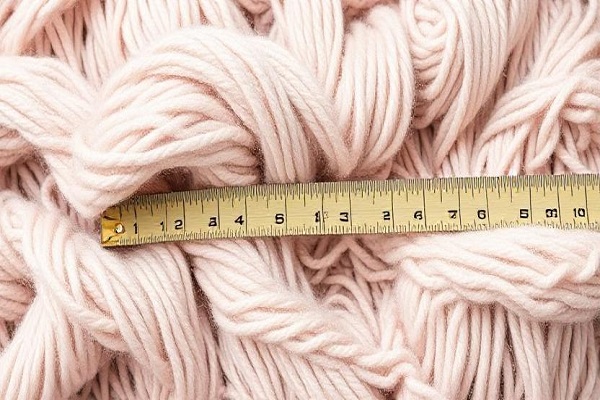Kilotex Calculator
© Yarn Count Ltd. All rights reserved.
Disclaimer: All tools in the Yarn Count have been reviewed by the relevant spinning industry experts.
The formula for Kilotex (ktex)
Kilotex = (Mass (grams) ÷ Length (meters))×1000
Where:
- Mass (grams): The weight of the fiber or yarn in grams.
- Length (meters): The total length of the fiber or yarn in meters.
- 1000: A conversion factor to express the result in kilotex (ktex), which represents grams per kilometer (g/km).
Table of Contents
What is Kilotex?
Kilotex (ktex) measures the mass of a fiber or yarn in grams per 1,000 meters. For example, a yarn with a kilotex of 50 weighs 50 grams per 1,000 meters. This unit is commonly used in industries like textiles, ropes, and technical fabrics.

Why Kilotex Matters in Textile Manufacturing
Measuring linear density with kilotex ensures consistent fiber characteristics across production runs. It directly affects fabric texture, strength, and performance. Manufacturers use kilotex measurements to standardize processes, maintain product quality, and meet industry specifications.
Key Benefits of Using Kilotex
- Consistency: Uniform yarn density results in consistent fabric quality.
- Efficiency: Simplifies calculations for fiber production.
- Quality Control: Ensures fibers meet required specifications.
- Material Optimization: Reduces waste by accurate material measurement.
How Kilotex is Calculated
The formula for calculating kilotex is straightforward:
Kilotex (ktex) = (Mass in grams / Length in meters) x 1000
Example Calculation:
If a yarn weighs 25 grams and its length is 500 meters:
Kilotex = (25 / 500) x 1000 = 50 ktex
This means the yarn has a linear density of 50 kilotex.
Kilotex in Different Textile Applications
1. Yarn Manufacturing:
Yarn producers use kilotex to ensure consistency across batches, influencing fabric appearance and durability.
2. Rope and Cordage Production:
Heavy-duty ropes require precise kilotex measurements for strength and performance.
3. Non-Woven Fabrics:
In technical textiles, accurate kilotex ensures reliability in products like medical and geotextiles.
4. Composites Industry:
Kilotex measurements are critical when using fibers like carbon and glass in high-performance applications.
Converting Kilotex to Other Units

Textile manufacturers often convert kilotex to units like tex and denier.
- Tex: Mass in grams per 1,000 meters. (1 ktex = 1,000 tex)
- Denier: Mass in grams per 9,000 meters. (1 ktex = 9000 denier)
Conversion Formulas:
- Tex = Kilotex x 1000
- Denier = Kilotex x 9000 / 1000 = Kilotex x 9
For example, if you have a yarn with 2 kilotex:
- Tex = 2 x 1000 = 2000 tex
- Denier = 2 x 9 = 18 denier
Factors Influencing Kilotex Values
Several factors can impact kilotex measurements:
- Fiber Type: Different fibers have varying densities.
- Production Methods: Variations in spinning techniques affect density.
- Environmental Conditions: Humidity and temperature can alter fiber mass.
Tools and Equipment for Measuring Kilotex
Accurate kilotex measurement requires specialized tools like:
- Precision Balances: For exact fiber mass.
- Yarn Length Testers: For consistent length measurement.
- Automated Kilotex Analyzers: For high-throughput production environments.
Practical Tips for Accurate Kilotex Measurement
- Use Calibrated Equipment: Regular calibration ensures reliable readings.
- Measure Multiple Samples: Average multiple results for greater accuracy.
- Control Environmental Conditions: Maintain stable temperature and humidity levels.
Kilotex and Textile Product Quality
Kilotex measurements help maintain product specifications for applications like:
- Apparel manufacturing
- Industrial textiles
- Technical fabrics
Inconsistent fiber density can lead to fabric defects, affecting product performance and customer satisfaction.
Conclusion
Kilotex is essential in textile manufacturing for measuring linear density accurately. It ensures product consistency, supports efficient production, and aids quality control. Understanding and applying kilotex measurements correctly helps manufacturers produce high-quality textile products that meet industry standards and customer expectations.